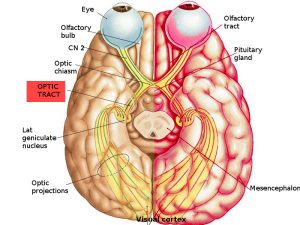 The optic chiasm or optic chiasma refers to the part of the brain where the optic nerves (CN II) partially cross.
The optic chiasm or optic chiasma refers to the part of the brain where the optic nerves (CN II) partially cross.
The optic chiasm is located at the bottom of the brain immediately below the hypothalamus.
The optic chiasm is the part of the brain where the optic nerves cross, located at the bottom of the brain immediately inferior to the hypothalamus.
A midline crossing of nerves inside the brain is called a decussation.
By partial decussation, the part of the visual field that is covered by both eyes is fused so that the processing of binocular depth perception by stereopsis is enabled.
The optic nerves of the left and the right eye meet in the body midline, ventral to the brain.
In the case of such partial decussation, the optic nerve fibers on the medial sides of each retina, which correspond to the lateral side of each visual hemifield, because the image is inverted, cross over to the opposite side of the body midline.
The inferonasal retina are related to the anterior portion of the optic chiasm whereas superonasal retinal fibers are related to the posterior portion of the optic chiasm.
The partial crossing over of optic nerve fibers at the optic chiasm allows the visual cortex to receive the same hemispheric visual field from both eyes.
The superimposition and processing of these monocular visual signals allows the visual cortex to generate binocular and stereoscopic vision.
The right cerebral hemisphere processes left visual hemifield, and the left cerebral hemisphere processes the right visual hemifield.
The net result is that the right cerebral hemisphere processes left visual hemifield, and the left cerebral hemisphere processes the right visual hemifield.
Beyond the optic chiasm, the optic nerves called the optic tracts have crossed and uncrossed fibers.
The optic tract inserts on the optic tectum (superior colliculus) of the midbrain.
They also branch off to the lateral geniculate body of the thalamus, in turn giving them to the occipital cortex of the cerebrum.
The number of axons that do not cross the midline and project ipsilaterally depends on the degree of binocular vision: 45% in humans do not cross.
Beyond the optic chiasm, with crossed and uncrossed fibers, the optic nerves become optic tracts.
The signals are passed on to the lateral geniculate body, in turn giving them to the occipital cortex.
